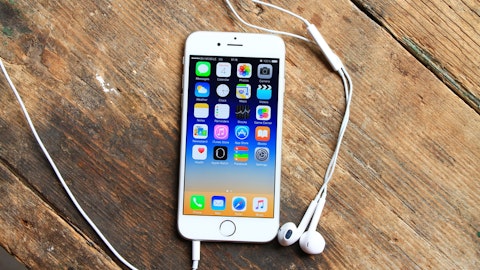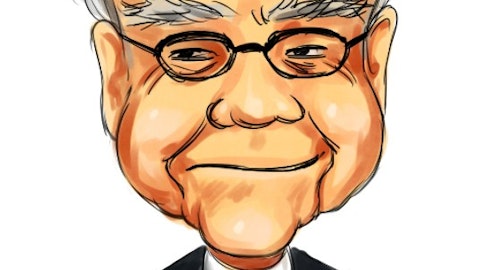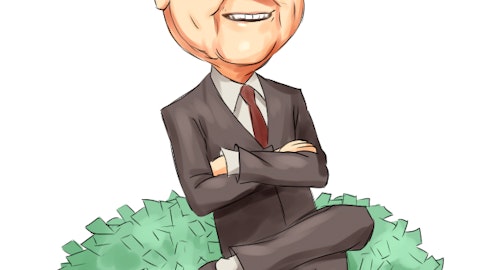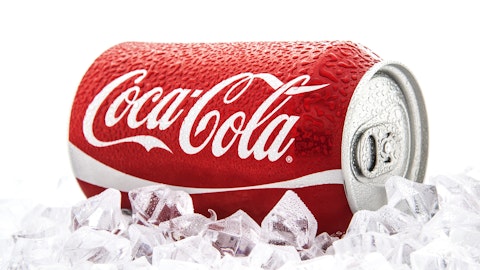Competitive Advantage
Coca-Cola’s competitive advantage is well-known. The company’s strength comes from its portfolio of high quality brands.
In addition to soda dominance, Coca-Cola has captured 1/3 of global juice growth since 2007. Coca-Cola controls well known juice brands including Simply (orange juice and other juices) and Minute Made.
In addition, Coca-Cola controls several strong tea and water brands including: Vitamin Water, Dasani, and Powerade.
The Coca-Cola Co (NYSE:KO) supports its strong brand competitive advantage through advertising spending. Coca-Cola has spent over $3 billion per year on advertising in each of its last 3 full fiscal years. This comes to about 7% of revenue per year spent on advertising.
Only PepsiCo (PEP) can come close to matching match Coca-Cola’s advertising spend in the beverage industry.
There are simply no other rivals for Coca-Cola in the non-alcoholic beverage industry that can match the companies advertising spending. The more Coca-Cola spends on advertising, the stronger its brands become.
In addition to its brand based competitive advantage, Coca-Cola also has a global distribution network that new entrants to the market would find very difficult to match.
Coca-Cola’s brand strength and distribution network create a market that is largely dominated by just 2 players (Coca-Cola and PepsiCo).
The beverage industry is different than most other industries in that it is very slow to change. Consumer tastes are slowly shifting away from sodas and toward juice, water, and tea in developed markets, but emphasis should be put on the word slowly. There are no rapid changes in the beverage industry.
It is virtually unthinkable for a new technology to come along that would antiquate the current beverage business. Odds are, people will continue to drink soda, juice, water, and tea. This makes Coca-Cola’s competitive advantages even more valuable as Coca-Cola is one of the few companies that could easily survive for several more centuries.
Coca-Cola and Warren Buffett
Warren Buffett first began purchasing the stock in 1988. 28 years later, Coca-Cola is Warren Buffett’s 3rd largest holding. The stock currently makes up 12.6% of his portfolio. Coca-Cola is one of Buffett’s 20 highest yielding stocks thanks to its 3.1% dividend yield.
Buffett is known to look for companies with strong competitive advantages in slow changing industries.
“Our approach is very much profiting from lack of change rather than from change”
Coca-Cola was founded in 1892. Its flagship product has changed very little sense that time. The biggest change came just 11 years after the soda was introduced; Coca-Cola removed the cocaine from its sodas in 1903. There are very few products that change as slowly as Coca-Cola, and very few industries that change as slowly as the beverage industry.
Coca-Cola has paid increasing dividends for 53 consecutive years. The company has a long history of rising profits.
“Time is the friend of the wonderful company, the enemy of the mediocre”
Coca-Cola stock is almost tailor made for Warren Buffett.
It combines his love for a strong and durable competitive advantage with his desire for businesses that change very slowly and are easy to understand.
Follow Warren Buffett's Berkshire Hathaway
Coca-Cola’s Total Return Analysis
Over the last decade, Coca-Cola has compounded its earnings-per-share at 5.9% a year while revenue has grown at 7.4% a year.
Earnings are expected to decline slightly in 2015 for Coca-Cola. On a constant-currency basis, earnings-per-share are expected to grow 5% in 2015.
Going forward, Coca-Cola expects to grow its earnings-per-share at between 7% and 9% a year over the long-run.
How the company can grow at this rate is shown below:
– Share repurchases of ~2% per year
– Revenue growth of 4% to 5% per year
– Margin improvements of 1% to 2% per year
Keep in mind that Coca-Cola has compounded revenue at 7.4% a year over the last decade. The company’s focus on margin improvements and share repurchases makes 7% to 9% earnings-per-share growth likely over the next decade for Coca-Cola.
In addition to 7% to 9% earnings-per-share growth, Coca-Cola stock currently has a ~3% yield for expected total returns of 10% to 12% per year.
Recession Performance
The Coca-Cola Co (NYSE:KO) was only minimally affected by the Great Recession of 2007 to 2009.
The company saw earnings-per-share decline by just 2.6% from 2008 to 2009 during the worst of the recession.
Coca-Cola’s low cost beverages are not significantly impacted by recessions as consumers tend to drink just as many beverages during times of economic trouble as during prosperous times.
Coca-Cola’s earnings-per-share through the Great Recession are shown below to illustrate how the company performs through recessions:
– 2007 Earnings-per-share of $1.29 (high at the time)
– 2008 Earnings-per-share of $1.51 (high at the time)
– 2009 Earnings-per-share of $1.47 (recession low)
– 2010 Earnings-per-share of $1.75 (new high)
Valuation and Final Thoughts
There are many reasons to invest in Coca-Cola:
– Strong competitive advantage in a slow changing industry
– Double-digit expected total returns
– Recession resistance
Unfortunately, valuation is not one of them.
Coca-Cola stock is currently trading for a price-to-earnings multiple of 21.8 times expected 2015 earnings. For comparison, the S&P 500 is currently trading for a price-to-earnings ratio of 19.8. Coca-Cola isn’t terribly overvalued, but it isn’t cheap at current prices either.
The combination of Coca-Cola’s low-risk business model and double-digit total returns help offset the company’s above-average valuation. Coca-Cola is currently ranked in the Top 50 using The 8 Rules of Dividend Investing. The company’s stock will become a more compelling buy when its price-to-earnings ratio drops below the S&P 500’s.
Disclosure: None





